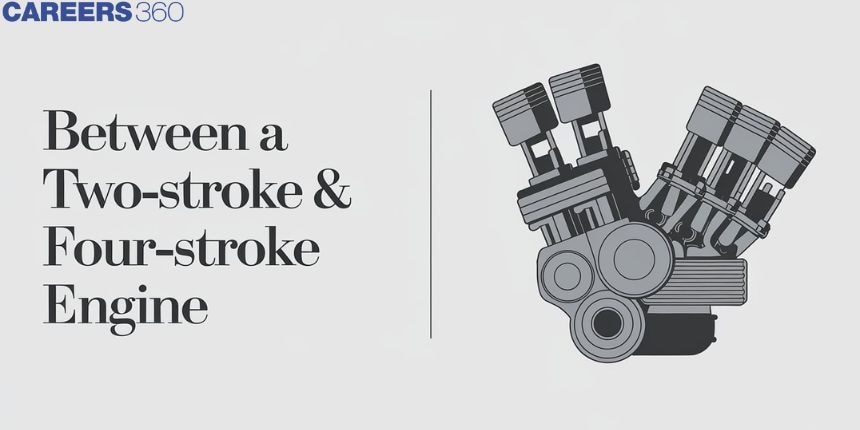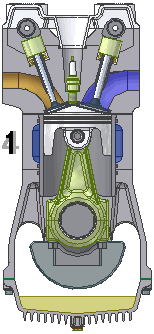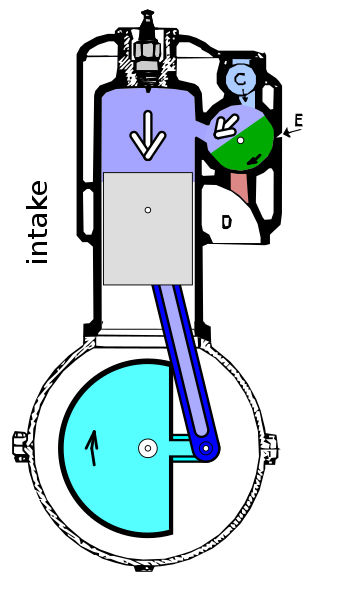Difference Between Two Stroke and Four Stroke - A Complete Guide
In most people's vehicle choices, motorcycles, scooters, and cars often use engines suited to specific applications, efficiencies, and power demands. Of the two types commonly used to power these vehicles, two-stroke and four-stroke engines, their differences go beyond technicalities, affecting fuel efficiency, maintenance, performance, and even environmental impact. Imagine two people running a race: one takes long strides at a steady pace, while the other sprints in short bursts. The first resembles a four-stroke engine, delivering power in well-coordinated cycles, while the second can be compared to a two-stroke engine, with quicker, less precise bursts of power.

In this article, we’ll explore the difference between two-stroke and four-stroke engines, offering a comparison that explains why each is suited for different applications, from motorcycles to heavy machinery.
4 Stroke Engine Working
The 4-stroke engine is a core component of internal combustion (IC) engines, known for their durability and performance. IC engines, using fuels like diesel, gasoline, and even renewable sources, perform combustion internally to produce energy. Here, a piston moves within a fixed cylinder, pressing down to rotate the crankshaft, which powers the wheels through a gear system. Most IC engines used in vehicles are four-stroke cycles. To complete a cycle, a four-stroke engine needs four piston strokes: intake, compression, ignition, and exhaust, distinguishing it in the 2 stroke vs 4 stroke comparison.

Most of these IC engines are four-stroke cycles. In four-stroke cycle engines, to complete one cycle it needs four piston strokes. There will be two valves: the intake valve and the exhaust valve.
Also, read
The four-piston strokes are
- Intake
- Compression
- Ignition
- Exhaust

1. Intake
- In this intake stroke, in the cylinder which is fixed part, the piston will move from the top position (TDC top dead centre) to the down position (BDC bottom dead center)
- Intake value will be open
- Exhaust value will be closed
- The piston which moves downwards will create a vacuum that sucks the fuel and air inside the engine through the intake valve which is opened in this process.
2. Compression Stroke
- In this compression stroke, the piston will now move from the down position (bottom dead center BDC) to the top position (TDC top dead center)
- The intake valve will be closed
- Exhaust value will be closed
- The piston which moves upwards will compress the sucked fuel and air (in the intake process) inside the combustion chamber.
- In this process, a spark of fire will be ignited.
|
Related Topics |
3. Power Stroke
- The spark fire which happens in the compression stroke will ignite the air and fuel. This ignition will force the piston to move back downwards, making the vehicle wheel to rotate forward.
- In this power stroke, the piston will now move from the top position (top dead center TDC) to the bottom position (BDC bottom dead center)
- The intake valve will be closed
- Exhaust value will be closed.
4. Exhaust stroke
- In this exhaust stroke, the piston will now move from the down position (bottom dead centre BDC) to the top position (TDC top dead centre)
- The intake valve will be closed
- Exhaust value will be opened
- This is the final process where the gas will be released through the exhaust valve of the cylinder. After completion of this process, the piston is now ready for the intake process.
2 Stroke Engine Working
The two-stroke engine, as its name suggests, completes its cycle in just two strokes:
- Compression stroke
- Power stroke

1. Compression Stroke
The piston compresses the fuel and air mixture as it moves upward. At the top of this stroke, a spark ignites the fuel, beginning the power stroke. The 2 stroke vs 4 stroke engine comparison often highlights this streamlined process in two-strokes for rapid power generation.
2. Power Stroke
Ignition drives the piston downwards, releasing exhaust gases through an exhaust port as it expels waste heat. This simplicity makes two-stroke engines lighter and cheaper, albeit with lower fuel efficiency and more emissions.
Difference Between Two Stroke and Four Stroke
|
Four-stroke engine
|
Two-stroke engine
|
|
In a four-stroke engine to complete the four-stroke process, it requires two complete revolutions.
| In a two-stroke engine to complete the two-stroke process it requires one complete revolution. |
The four-piston strokes are
| The two-stroke is
|
| The inlet valve and exhaust valve | The inlet port and exhaust port |
| Consumption of fuel is full | Consumption of fuel is not full |
| High thermal efficiency and less smoke | Low thermal efficiency and high smoke |
| Exhaust gas is removed easily | Exhaust gas removal is difficult |
| Engine weight is high per hp because the flywheel is high | Engine weight is comparatively less per hp |
| Low torque | High torque |
| Tough to manufacture and engines are costlier due to lubrication and valves. | Simple to manufacture and engines are cheap |
| More wear and tear happens because of poor lubrication | Wear and tear are less |
| Speed can be varied from high to low | High-speed engines are mostly available |
| Operates in only one direction | Operates in both directions (anti-clockwise direction and clockwise direction) |
Application of two-stroke and four-stroke engine
|
Four-stroke engine
|
Two-stroke engine
|
|
Automobiles like cars, trucks and some bikes use fuel like gasoline, aircraft
| Chainsaws, motorcycles, racing applications, weed eaters, military tanks, ships. |
| In four-stroke engines are lubricated by oil so they are not flexible in cold temperatures | In a two-stroke oil sump is not in design hence it can be easily started in cold conditions. |
| High expensive and low noisy | Less expensive and more noisy |
All the above-mentioned points explain the difference between two-stroke and four-stroke engines/the difference between 2 stroke and 4 stroke engines/2-stroke vs 4-stroke.
Frequently Asked Questions (FAQs)
Practically there are four processes to perform such as intake, compression, ignition, and exhaustion. Leaving any one process we can’t operate an engine. Hence 3 stroke engine is not possible.
In four stroke cycle engines, to complete one cycle it needs four piston strokes. There will be two valves: intake valve and exhaust valve.
The four piston strokes are
Intake
Compression
Ignition
Exhaust
In a two stroke engine for the same engine speed, it develops twice the number of power strokes compared to four stroke engine cycle. Compared to a four stroke engine for the same power developed, the two stroke engine is not bulky, lighter and floor area occupied is less.
Stroke is the movement of a piston. A 2 stroke engine has two motions for the piston. Similarly 4 stroke engine has four motions for the piston. Hence two stroke engine will accelerate faster and unstable.
4 stroke engine | 2 stroke engine |
Low torque | High torque |
Tough to manufacture and engines are costlier due to lubrication and valve. | Simple to manufacture and engines are cheap |
More wear and tear happens because of poor lubrication | Wear and tear are less |
Speed can be varied from high to low | High speed engine are mostly available |
Operates in only one direction | Operates in both direction (anti clockwise direction and clockwise direction) |